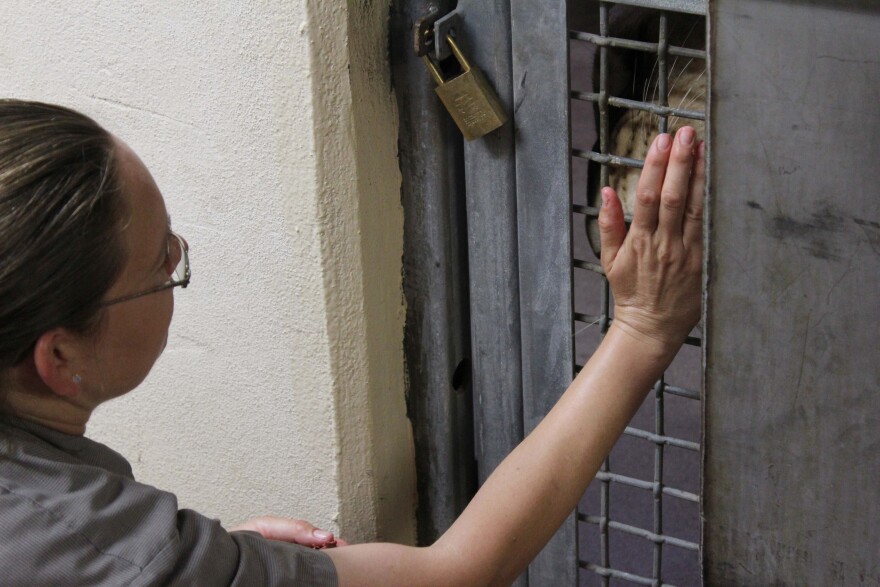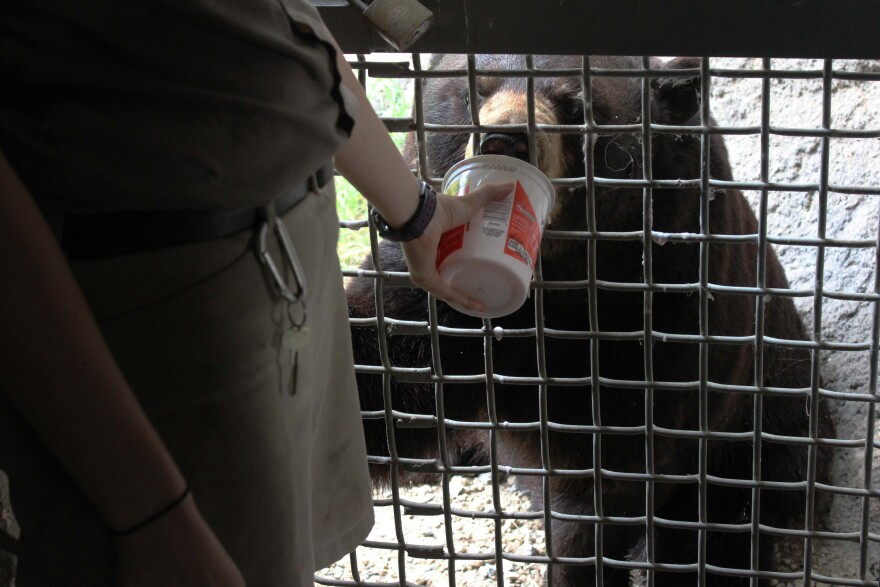This piece originally aired Friday, July 24, during Morning Edition.
The unsung heroes of many zoos across the country are the men and women who are there day and night, during snowstorms and heat advisories. Zookeepers are part caregiver, part trainer and part housekeeper for thousands of different kinds of animals. KMUW’s Sean Sandefur got a behind-the-scenes look at the Sedgwick County Zoo in time for National Zookeeper Week.
The Sedgwick County Zoo is home to 3,000 animals representing nearly 400 different species. Some are ferocious, some are adorable and some are both, and it takes a staff of more than 60 zookeepers and veterinarians to care for them.

Micala Teetzen is one of those zookeepers. She’s petite, though the zoos lions she looks after--including 400-pound Michael and lioness Kianga--are not.
Teetzen is feeding the lions on a recent Monday. The animals are fed processed meat, and a knucklebone twice a week.

Michael scarfs down huge bits of raw, ground beef sent into his cage through chutes; Kianga is more patient. Teetzen takes some of the ground beef in her hand and places it flat against the cage. The massive lioness gently licks her hand clean.
Once the lions have devoured every last bite, Teetzen walks outside to the exhibit, with Kianga and Michael safely behind in their cages. Huge, fabricated rocks are tucked into tall grass.
Teetzen says feeding these animals is only a small part of her job.
“I’d say 75 percent of our job is cleaning. It’s also part education, like doing keeper chats and talking to people; it’s part handyman and repair work; it’s part maid, part nurse. It’s multi-faceted," she says. "[It's the] highest degree-requiring, lowest paying, manual labor jobs there is. We work on weekends, we work on holidays. In the snow, in the sun, in the rain.”

A bachelor’s degree in animal science or zoology is often required, and the average zookeeper salary in the U.S. is just $29,000. But despite the long hours and less-than-favorable pay, the passion and happiness is obvious on the faces of those working at the Sedgwick County Zoo. Faces like Jordan Wiltse, who has worked in the Tropics exhibit for the past couple of years.
“I have always wanted to be a zookeeper," Wiltse says. "The older I got and the more involved I got, the more I realized how involved zoos are in conservation. And I think that’s a really important thing for the world to focus on right now. It's not just what we have in our zoos, but what’s out there that we can try and protect.”
Zookeepers truly take on a parental role—whether it’s a 400-pound lion that could maul you to death, or a great blue turaco that eats grapes from your hand. These caregivers do more than keep zoo animals alive: they do their dishes, they pick up after them, they entertain them.
They keep them happy and healthy.
“I can guarantee you I love my birds just like people love their children," Wiltse says. "These guys are incredibly important to me and I do everything I can do make sure they have the best life possible here.”

There’s another job that’s required of many of zookeepers: training. Over at the black bear exhibit, zookeeper Maggie Mann does her best to get a 350-pound female black bear named Ursa to follow her commands.
Through a large, steel cage Mann uses a purple ball to show where she wants the bear to place her nose. When Ursa responds, she hears a loud click, which reinforces her good behavior. Mann does this not only for light exercise, but so the bears will stay put when staff need to administer shots. Ursa always receives some strawberry yogurt for her work.
Although Mann spends over 40 hours a week with these animals, she must keep her distance for the sake of safety. She says her relationship with large animals like Ursa is based on respect, but she admits that she takes advantage anytime she is able to pet them.
“We did dental exams on them and we definitely took advantage and touched their ears and everything like that while they were under," Mann says. "But at the same time, what I love about working with bears is that they’re wild. And as frustrating as it can sometimes be, they’re 100 percent their own animal.”

If there were ever a zoo animal to show up all other zoo animals, it would be the African elephant. These 4-ton creatures can have the intelligence level of a 6th grader.

Kinna Middleton is one of the zookeepers who looks after Stephanie the elephant, one of Sedgwick County Zoo’s most famous animals. Stephanie's longtime counterpart, Cinda, passed away last year. Middleton says it was tough on the whole zoo, but Stephanie is still living happily.

"She’s always had an only-child mentality, and she’s doing quite well now," Middleton says. "She doesn’t have to share.”
Stephanie, who weighs roughly 7,000 pounds, has been at the zoo since the 1970s. Middleton echoes what other zookeepers have said: that zoos can bring attention to threatened animals across the world. She says Stephanie has educated generations of children to the plight of the African elephant.
"They’re still highly poached and there’s not enough land, not enough resources, there’s too many people," Middleton says. "So there really is no wild left anymore. So elephants like Stephanie are ambassadors for their species."

For many zookeepers, talking with visitors is a big part of their job. Kimberly Olsen works in the Sedgwick County Zoo's "Farm" section. It features domesticated animals from around the world. Milk Dud is a zebu, a species of cattle that can be found in the arid regions of the Himalayans.
Listen below as Kimberly Olsen talks about Milk Dud the Zebu
--
To contact KMUW News or to send in a news tip, reach us at news@kmuw.org.
Follow Sean Sandefur on Twitter @SeanSandefur



